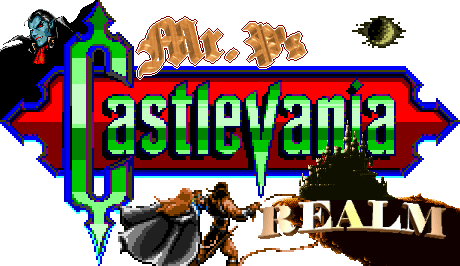
![]() More Consistent Chaos
More Consistent Chaos ![]()
The Expanded Entrance
  |
| When you first begin in Symphony of the Night (or its cousin over on the Saturn), your character will hop over the drawbridge and slip into the castle, its doors slamming shut. Using their super-jumping ability (or Alucard's bat ability), the heroes can work their way upward into a closed-off storage room to find a power-up directly above the entryway . In Circle of the Moon, you will eventually work your way up from the castle depths to find the main halls; outside, you'll find the same entryway. You can use Nathan's super jump to reach that same closed-off storage room for a power-up. The main graphic similarity in both games is the shrub-lined brick wall in the background. The castle gardeners probably cut down all of trees between the 40-year-plus period before Nathan and friends arrived here. |
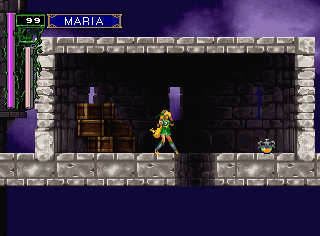  |
| We find this instance once again in Castlevania: Aria of Sorrow, which is situated in an atypical time-period. So, obviously, a lot has changed since the 1800's and Nathan's trials. To wit: The expanded entrance has now been encapsulated as an actual part of the castle, the woodland view eliminated in favor of stone walls, statues and some shrubbery. What hasn't changed is the structure: Soma Cruz will begin his adventure at the familiar entrance, where friendly forces will gather as it rages on, and he can eventually charge his way upward either by superjumping or by flying up in bat form. As usual, a power-up (in this case a Lucky Charm) awaits. |
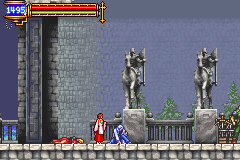
![]()
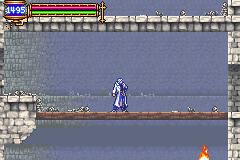
![]()
![]()
![]()
The Cursed Prison
 |
| When Castlevania: Symphony of the Night was ported over to the Sega Saturn by KCEN, they created a new area called the "Cursed Prison," a rather pointless maze-like area (zigzagging, you could say) where the visuals do most of the work; in the background, you'll see the chained and lynched remains of the unfortunate souls sent to die here. What may have been happening here was KCEN testing out an idea in preparation for their next project--Castlevania Legends. Indeed, we can see that they were building to the dungeon that was to be the game's bonus stage. Like its predecessor, it's a maze of platforms, and you can see the remains of people sent here. Even the pesky spear guards return to impede your progress. |
 |
![]()
![]()
![]()
The Waterway
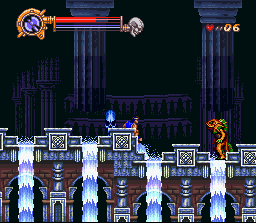
![]()
| After saving Maria in Castlevania: Dracula X, you could use a key to open a locked door leading to the hidden springs and thus escape from the catacombs. Structure- and position-wise, Circle of the Moon's waterway is very similar. You can see, however, where KCEK's influence for the latter part of this area comes from. In the last part of each area, you'll be accosted by merman/fishman and foes that fly in from above. Soon after, you'll enter into a boss room outlined by a series of waterfalls. |
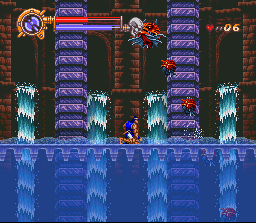
![]()
![]()
![]()
![]()
Ruinous Path

![]()
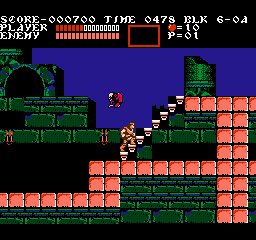
| A more specific instance of familiarity within the outside ruins is showcased between two NES entries: Castlevania and Dracula's Curse. There are two sections of one stage that are slightly different but altogether similar. The first part of the puzzle is the path Frank's cavern. In Castlevania, as we know, it's where the eagles are dropping hunchbacks. In Dracula's Curse, on Stage 8, there's an initial path where there's a hunchback attack followed by a water-filled bridge. Amazingly, in both games, this path measures exactly 94 blocks, and they both feature backgrounds with the same damaged pillars. Thereafter, you'll enter into the cavern, where the similarities are more easily noticed--the graphics are completely recycled. You have the same pillars, arches, blue bricks and block patterns, and, again, the block distance is identical--64 blocks for this part of the path. From this, we can see that before it was left in ruins, it served as a bridge to redirect water into the caverns below (perhaps into Stage 9, the caverns that mirror the first area of Castlevania's Stage 4). The well, apparently, went dry. (Suggested by MeWiseMagic03.) |

![]()

![]()
![]()
![]()
Town Before the Town

![]()

| You've learned about Jova and how it changed from the time of Simon to the more advanced time of Richter. But the town started taking form even before that, two hundred years before Simon even made residence here. It started in that remote area of Warakiya, the ravaged village where Trevor starts his adventure in Dracula's Curse. The creators of Rondo took this entire stage design into consideration, almost block by block, and they envisioned a more bustling version--starting with the town entrance shown above, with the staircase-platform combo and the torches placed underneath. |

![]()
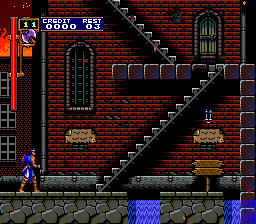
| This part is less noticeable, but the giant stone wall, guarded by two skeletons, was the foundation of Jova--sort of an early construction site. In Dracula's Curse, this leads to a small chapel area and then exits back into the town. This chapel could very well be the innards of the Church of Jova that will soon stand in Simon's Quest. |
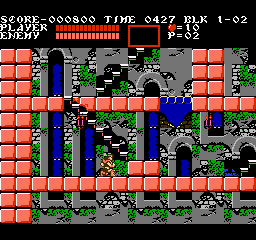
![]()

| Here's the other side of the wall, what will become the end of this part of town. Eventually, the citizens will clear out all of the Medusa Heads, eliminate that annoying rotating platform that they can't stop falling through, and add a doorway. Soon after, they'll upgrade the town's wood-bearing scheme to a more modern look and clear away the graveyard to add trees and plant life. |

![]()

| Where Trevor fights the Skull Knight will eventually become the end of town, where they'll put up a wall to represent its exit. Eventually, both Simon and Richter will see this as the start of their journeys, where the castle's silhouette looms over the town. (Suggested by MeWiseMagic03.) |
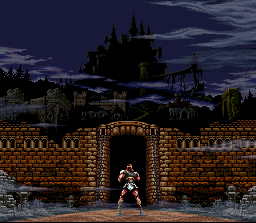
![]()
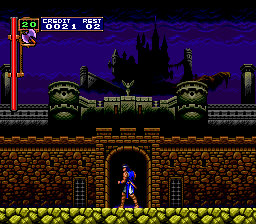
![]()
![]()
![]()
The Dungeon

![]()

|
The fifth stage of Castlevania, the dungeon, is regarded as one of the more infamous, for its energy-gobbling baddies and its considerable boss guardian, the Grim Reaper. Konami knew well that fear and sought to play upon it by patching in a reminder every now and then. The dungeon is immediately noticeable by the elements of its entrance room: Its hewn-in prison chambers, its holding contraptions, the dreary color tone, the remains of its habitants, the skeletons, and the dreaded hunchbacks. None is more obvious than stage seven of Akumajou Dracula X68000, which is its own rendition of the Simon's NES adventure; its dungeon is remake of that classic stage and features the same decor. New additions include living prison habitants--mainly the two-headed beast that breaks free. One hundred years later (in Rondo of Blood), Richter would pass through this same room only to encounter the same obstacles. And five years later (in Symphony), Alucard would find a slightly refurbished dungeon entrance, inhabited only by bloody zombies. Its dungeon is a part of Olrox's Quarters, stuffed high up in its top-right corner. The positioning is correct because we've already established that Olrox's Chamber represents the ruins, and in Castlevania, the ruins lead upward, into the dungeon. (Suggested by Kev.) |
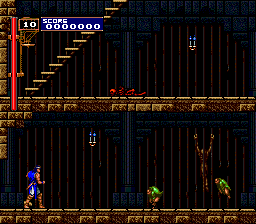
![]()

![]()
![]()
![]()
Flames of Cerberus

![]()
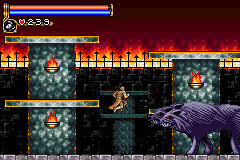
|
It's no stretch to say that the developers from the now-defunct KCEK were paying really close attention to Symphony of the Night and its design when they created Circle of the Moon. It inspired their choice of genre, their use of names, and even some overlooked battle scenarios (the expanded entrance, for instance). Another overlooked scenario is the Cerberus battle. In Symphony, Alucard will meet up with the hound from Hell in a long room located in the Abandoned Mine, where the raging flames make the beast feel right at home. In Circle of the Moon, the map position is just about identical: In the catacombs, a like underground area, Nathan Graves will accost the multi-headed hound a long room highlighted by the raging flames of Hell. In both screenshots, you can even see that the rooms' platforms match each other in height and distance. (Suggested by Kev.) |
Page 3: Even More
Similarities | Back
to Page 1
|
[Home] [What's New?] [CV Library] [Stages] [Reviews] [Weapons] [Castleography] [Multimedia] [Codes] [Links] |
||||
